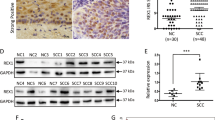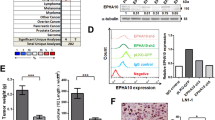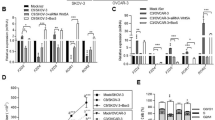Abstract
Loss of the cell adhesion protein E-cadherin increases the invasive capability of ovarian cancer cells. We have previously shown that epidermal growth factor (EGF) downregulates E-cadherin and induces ovarian cancer cell invasion through the H2O2/p38 MAPK-mediated upregulation of the E-cadherin transcriptional repressor Snail. However, the molecular mechanisms underlying the EGF-induced downregulation of E-cadherin are not fully understood. In the current study, we demonstrated that treatment of two ovarian cancer cell lines, SKOV3 and OVCAR5, with EGF induced the expression of the transcription factor Egr-1, and this induction was abolished by small interfering RNA (siRNA)-mediated depletion of the EGF receptor. EGF-induced Egr-1 expression required the activation of the ERK1/2 and PI3K/Akt signaling pathways and was unrelated to EGF-induced H2O2 production and activation of the p38 MAPK pathway. Moreover, depletion of Egr-1 with siRNA abolished the EGF-induced downregulation of E-cadherin and increased cell invasion. Interestingly, siRNA depletion of Egr-1 attenuated the EGF-induced expression of Slug, but not that of Snail. Moreover, chromatin immunoprecipitation (ChIP) analysis showed that Slug is a target gene of Egr-1. These results provide evidence that Egr-1 is a mediator that is involved in the EGF-induced downregulation of E-cadherin and increased cell invasion. Our results also demonstrate that EGF activates two independent signaling pathways, which are the H2O2/p38 MAPK-mediated upregulation of Snail expression and the Egr-1-mediated upregulation of Slug expression. These two signaling pathways contribute to the EGF-induced downregulation of E-cadherin, which subsequently increases the invasive capability of ovarian cancer cells.
This is a preview of subscription content, access via your institution
Access options
Subscribe to this journal
Receive 50 print issues and online access
$259.00 per year
only $5.18 per issue
Buy this article
- Purchase on Springer Link
- Instant access to full article PDF
Prices may be subject to local taxes which are calculated during checkout








Similar content being viewed by others
References
Pecina-Slaus N . Tumor suppressor gene E-cadherin and its role in normal and malignant cells. Cancer Cell Int 2003; 3: 17.
Perez-Moreno M, Jamora C, Fuchs E . Sticky business: orchestrating cellular signals at adherens junctions. Cell 2003; 112: 535–548.
Thiery JP . Epithelial-mesenchymal transitions in tumour progression. Nat Rev Cancer 2002; 2: 442–454.
Thiery JP, Sleeman JP . Complex networks orchestrate epithelial-mesenchymal transitions. Nat Rev Mol Cell Biol 2006; 7: 131–142.
Peinado H, Olmeda D, Cano A . Snail Zeb and bHLH factors in tumour progression: an alliance against the epithelial phenotype? Nat Rev Cancer 2007; 7: 415–428.
Veatch AL, Carson LF, Ramakrishnan S . Differential expression of the cell-cell adhesion molecule E-cadherin in ascites and solid human ovarian tumor cells. Int J Cancer 1994; 58: 393–399.
Darai E, Scoazec JY, Walker-Combrouze F, Mlika-Cabanne N, Feldmann G, Madelenat P et al. Expression of cadherins in benign, borderline, and malignant ovarian epithelial tumors: a clinicopathologic study of 60 cases. Hum Pathol 1997; 28: 922–928.
Barr S, Thomson S, Buck E, Russo S, Petti F, Sujka-Kwok I et al. Bypassing cellular EGF receptor dependence through epithelial-to-mesenchymal-like transitions. Clin Exp Metastasis 2008; 25: 685–693.
Bartlett JM, Langdon SP, Simpson BJ, Stewart M, Katsaros D, Sismondi P et al. The prognostic value of epidermal growth factor receptor mRNA expression in primary ovarian cancer. Br J Cancer 1996; 73: 301–306.
Niikura H, Sasano H, Sato S, Yajima A . Expression of epidermal growth factor-related proteins and epidermal growth factor receptor in common epithelial ovarian tumors. Int J Gynecol Pathol 1997; 16: 60–68.
Mendelsohn J, Baselga J . Status of epidermal growth factor receptor antagonists in the biology and treatment of cancer. J Clin Oncol 2003; 21: 2787–2799.
Cowden Dahl KD, Symowicz J, Ning Y, Gutierrez E, Fishman DA, Adley BP et al. Matrix metalloproteinase 9 is a mediator of epidermal growth factor-dependent e-cadherin loss in ovarian carcinoma cells. Cancer Res 2008; 68: 4606–4613.
Xu Z, Jiang Y, Steed H, Davidge S, Fu Y . TGFbeta and EGF synergistically induce a more invasive phenotype of epithelial ovarian cancer cells. Biochem Biophys Res Commun 2010; 401: 376–381.
Cheng JC, Klausen C, Leung PC . Hydrogen peroxide mediates EGF-induced down-regulation of E-cadherin expression via p38 MAPK and snail in human ovarian cancer cells. Mol Endocrinol 2010; 24: 1569–1580.
Sukhatme VP, Cao XM, Chang LC, Tsai-Morris CH, Stamenkovich D, Ferreira PC et al. A zinc finger-encoding gene coregulated with c-fos during growth and differentiation, and after cellular depolarization. Cell 1988; 53: 37–43.
Gashler A, Sukhatme VP . Early growth response protein 1 (Egr-1): prototype of a zinc-finger family of transcription factors. Prog Nucleic Acid Res Mol Biol 1995; 50: 191–224.
Cao X, Mahendran R, Guy GR, Tan YH . Detection and characterization of cellular EGR-1 binding to its recognition site. J Biol Chem 1993; 268: 16949–16957.
Thiel G, Cibelli G . Regulation of life and death by the zinc finger transcription factor Egr-1. J Cell Physiol 2002; 193: 287–292.
Fahmy RG, Dass CR, Sun LQ, Chesterman CN, Khachigian LM . Transcription factor Egr-1 supports FGF-dependent angiogenesis during neovascularization and tumor growth. Nat Med 2003; 9: 1026–1032.
Kaufmann K, Thiel G . Epidermal growth factor and platelet-derived growth factor induce expression of Egr-1, a zinc finger transcription factor, in human malignant glioma cells. J Neurol Sci 2001; 189: 83–91.
Bouchard F, Belanger SD, Biron-Pain K, St-Pierre Y . EGR-1 activation by EGF inhibits MMP-9 expression and lymphoma growth. Blood 2010; 116: 759–766.
Tsai JC, Liu L, Zhang J, Spokes KC, Topper JN, Aird WC . Epidermal growth factor induces Egr-1 promoter activity in hepatocytes in vitro and in vivo. Am J Physiol Gastrointest Liver Physiol 2001; 281: G1271–G1278.
Grotegut S, von Schweinitz D, Christofori G, Lehembre F . Hepatocyte growth factor induces cell scattering through MAPK/Egr-1-mediated upregulation of Snail. Embo J 2006; 25: 3534–3545.
Vergara D, Merlot B, Lucot JP, Collinet P, Vinatier D, Fournier I et al. Epithelial-mesenchymal transition in ovarian cancer. Cancer Lett 2010; 291: 59–66.
Bain J, McLauchlan H, Elliott M, Cohen P . The specificities of protein kinase inhibitors: an update. Biochem J 2003; 371: 199–204.
Davies SP, Reddy H, Caivano M, Cohen P . Specificity and mechanism of action of some commonly used protein kinase inhibitors. Biochem J 2000; 351: 95–105.
Tsunoda T, Takagi T . Estimating transcription factor bindability on DNA. Bioinformatics 1999; 15: 622–630.
Lu Z, Ghosh S, Wang Z, Hunter T . Downregulation of caveolin-1 function by EGF leads to the loss of E-cadherin, increased transcriptional activity of beta-catenin, and enhanced tumor cell invasion. Cancer Cell 2003; 4: 499–515.
Baron V, Duss S, Rhim J, Mercola D . Antisense to the early growth response-1 gene (Egr-1) inhibits prostate tumor development in TRAMP mice. Ann NY Acad Sci 2003; 1002: 197–216.
Salah Z, Maoz M, Pizov G, Bar-Shavit R . Transcriptional regulation of human protease-activated receptor 1: a role for the early growth response-1 protein in prostate cancer. Cancer Res 2007; 67: 9835–9843.
Abdulkadir SA, Qu Z, Garabedian E, Song SK, Peters TJ, Svaren J et al. Impaired prostate tumorigenesis in Egr1-deficient mice. Nat Med 2001; 7: 101–107.
Huang RP, Fan Y, de Belle I, Niemeyer C, Gottardis MM, Mercola D et al. Decreased Egr-1 expression in human, mouse and rat mammary cells and tissues correlates with tumor formation. Int J Cancer 1997; 72: 102–109.
Liu C, Adamson E, Mercola D . Transcription factor EGR-1 suppresses the growth and transformation of human HT-1080 fibrosarcoma cells by induction of transforming growth factor beta 1. Proc Natl Acad Sci USA 1996; 93: 11831–11836.
Kuo PL, Chen YH, Chen TC, Shen KH, Hsu YL . CXCL5/ENA78 increased cell migration and epithelial-to-mesenchymal transition of hormone-independent prostate cancer by early growth response-1/snail signaling pathway. J Cell Physiol 2011; 226: 1224–1231.
Cabodi S, Morello V, Masi A, Cicchi R, Broggio C, Distefano P et al. Convergence of integrins and EGF receptor signaling via PI3K/Akt/FoxO pathway in early gene Egr-1 expression. J Cell Physiol 2009; 218: 294–303.
Kim CG, Choi BH, Son SW, Yi SJ, Shin SY, Lee YH . Tamoxifen-induced activation of p21Waf1/Cip1 gene transcription is mediated by early growth response-1 protein through the JNK and p38 MAP kinase/Elk-1 cascades in MDA-MB-361 breast carcinoma cells. Cell Signal 2007; 19: 1290–1300.
Mayer SI, Rossler OG, Endo T, Charnay P, Thiel G . Epidermal-growth-factor-induced proliferation of astrocytes requires Egr transcription factors. J Cell Sci 2009; 122: 3340–3350.
Jones N, Agani FH . Hyperoxia induces Egr-1 expression through activation of extracellular signal-regulated kinase 1/2 pathway. J Cell Physiol 2003; 196: 326–333.
Batlle E, Sancho E, Franci C, Dominguez D, Monfar M, Baulida J et al. The transcription factor snail is a repressor of E-cadherin gene expression in epithelial tumour cells. Nat Cell Biol 2000; 2: 84–89.
Bolos V, Peinado H, Perez-Moreno MA, Fraga MF, Esteller M, Cano A . The transcription factor Slug represses E-cadherin expression and induces epithelial to mesenchymal transitions: a comparison with Snail and E47 repressors. J Cell Sci 2003; 116: 499–511.
Barbera MJ, Puig I, Dominguez D, Julien-Grille S, Guaita-Esteruelas S, Peiro S et al. Regulation of Snail transcription during epithelial to mesenchymal transition of tumor cells. Oncogene 2004; 23: 7345–7354.
Ackerman SL, Minden AG, Williams GT, Bobonis C, Yeung CY . Functional significance of an overlapping consensus binding motif for Sp1 and Zif268 in the murine adenosine deaminase gene promoter. Proc Natl Acad Sci USA 1991; 88: 7523–7527.
Shingu T, Bornstein P . Overlapping Egr-1 and Sp1 sites function in the regulation of transcription of the mouse thrombospondin 1 gene. J Biol Chem 1994; 269: 32551–32557.
Woo MM, Salamanca CM, Minor A, Auersperg N . An improved assay to quantitate the invasiveness of cells in modified Boyden chambers. In Vitro Cell Dev Biol Anim 2007; 43: 7–9.
Acknowledgements
This work was supported by grants from Canadian Institutes of Health Research to PCKL. PCKL is the recipient of a Child & Family Research Institute Senior Investigator Award. JCC is the recipient of BC Foundation for Non-Animal Research-Evelyn Martin Memorial Fellowship.
Author information
Authors and Affiliations
Corresponding author
Ethics declarations
Competing interests
The authors declare no conflict of interest.
Additional information
Supplementary Information accompanies the paper on the Oncogene website
Supplementary information
Rights and permissions
About this article
Cite this article
Cheng, JC., Chang, HM. & Leung, P. Egr-1 mediates epidermal growth factor-induced downregulation of E-cadherin expression via Slug in human ovarian cancer cells. Oncogene 32, 1041–1049 (2013). https://doi.org/10.1038/onc.2012.127
Received:
Revised:
Accepted:
Published:
Issue Date:
DOI: https://doi.org/10.1038/onc.2012.127
Keywords
This article is cited by
-
GDNF-RET signaling and EGR1 form a positive feedback loop that promotes tamoxifen resistance via cyclin D1
BMC Cancer (2023)
-
Chromatin accessibility landscape and active transcription factors in primary human invasive lobular and ductal breast carcinomas
Breast Cancer Research (2022)
-
Absence of EpCAM in cervical cancer cells is involved in slug induced epithelial-mesenchymal transition
Cancer Cell International (2021)
-
Friend or foe, the role of EGR-1 in cancer
Medical Oncology (2020)
-
Identification of upstream miRNAs of SNAI2 and their influence on the metastasis of gastrointestinal stromal tumors
Cancer Cell International (2019)



